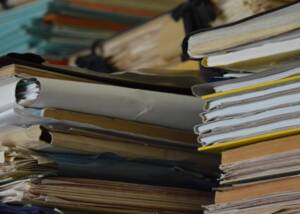Paper consumption in Germany - a brief outline
News News blog
What used to be papyrus, hemp or bamboo is now paper or cardboard. The mass medium has an interesting history with some important milestones behind it: from the development of the first bleaching agent, to industrial paper production, to digitisation, paper products and the way we deal with them have changed.

A look back: the paper industry over time
The paper industry was strongly linked to science and culture early on after the invention of paper: In ancient times and the Middle Ages, writings were mainly used by scholars. This is different today, because nowadays paper is more than just a medium for conveying knowledge. Since the end of the 19th century, it has also been essential for the production of packaging, hygiene articles, office supplies, toys and even furnishings. 200 years ago, however, industrial paper production was not yet what it is today. Since then, it has developed rapidly. In 1850, the world produced about 100,000 tonnes of pulp products a year. Today, paper machines are up to 300 metres long and produce up to 1,500 tonnes of paper products per day. Worldwide, they now produce more than 300 million tonnes a year!
The development of bleach
Bleach was first produced from chlorine gas, concentrated sulphuric acid and manganese dioxide in 1785. This discovery had a massive impact on the paper industry: for the first time it was possible to produce white sheets without cumbersome processes. However, this bleaching agent, which was developed by the Frenchman Berthollet, is no longer used in Germany today because the chlorine gas it contains is harmful to the environment. Since the 1980s, the industry has changed and now uses more environmentally friendly alternatives such as hydrogen peroxide, oxygen or ozone for paper production.
Modern paper manufacturing
In contrast to the increase in paper consumption, the process of papermaking has changed little over time. Since the invention of groundwood pulp in 1843, large-scale machine papermaking has become possible. Before that, it could only be made by hand, by scooping individual sheets. This is no longer the case with the machine process, because here one has an endless paper web at one's disposal. As a result, paper mills were gradually replaced by large factories - industrialisation took its course.
Today, modern paper machines are also bigger and faster. They can consist of more than a hundred guide rollers for wires, felts and paper web and are equipped with a large number of drying cylinders. Today's paper machines are also so powerful that they can produce up to 2000 metres of paper products per minute - this is especially necessary for mass media such as newsprint or corrugated tube paper.
Another special feature of modern paper production is the integration of computer-aided process control systems. This enables constant control of factors relevant to production, such as basis weight or paper web moisture. This in turn is important in order to produce ideal running and processing properties in the production and further processing of corrugated board and to achieve uniform, efficient cross profiles and longitudinal trends.
The paper industry today
Today, the paper industry is dominated by international companies. In 2019, Germany was among the world's largest paper producers, along with Japan, China and the USA, with a production of 22.1 million tonnes of paper products. 22% of the paper produced is needed in Europe alone. Due to the stabilisation of the industry and the simultaneous growth in demand for paper, the number of paper mills in Europe has declined in recent years, while production figures have skyrocketed. In 2020, although paper production decreased slightly, there were clear differences in the different segments: Paper made into packaging was more in demand than in the previous year, while the number of graphic papers (paper for printing, writing and copying) dropped significantly.
Consequences of digitisation
If one thinks of digitisation, the conclusion that paper consumption will gradually decrease as a result is obvious. However, if we look at the last decade, this assumption has turned out to be wrong. In fact, despite digitisation, Germans now consume more pulp products than before. But paper consumption is also rising steadily worldwide. How can this be possible?
A turning point in the paper industry
Digitisation is considered an important turning point in the paper industry. Since the invention of the computer and at the latest since everyone has gone online, it was thought that the consumption of paper goods would decline. To some extent, this has turned out to be true: Many prefer to use e-readers instead of printed books and magazines or work with digital instead of printed documents. Nevertheless, this part only makes up a small percentage of what still does not function entirely without paper: Invoices, order and delivery notes, parcels, documents, mails, et cetera are still printed out - although this is often not necessary. The biggest problem is with consumption: in the course of digitisation, it has become easier to order often and quickly online. Moreover, we increasingly work online. Nevertheless, many people prefer to print out their documents to work with. Even though digitisation offers many advantages, the consumption per capita of paper products is increasing as a result. For example, many companies send a printed invoice along with the goods when an order is placed online - even though it has already been sent by e-mail.
Often, what is printed out is not even read later. In German offices, as many as six per cent of printouts end up in the wastepaper basket unread. In countries like Italy, it is even more: here, 17 per cent are wasted in this way. This not only causes waste, but also does enormous damage to the environment.
The answer from the paper industry: recycled paper
Despite the enormous criticism from environmentalists, the paper industry has managed to address the problem of increasing paper consumption. An environmentally friendly alternative to conventional primary-fibre paper has always been so-called recycled paper, which can be made from waste paper that has already been used. Recycled paper saves up to 60% energy and up to 70% water compared to primary fibre paper, it therefore produces less CO2 and reduces waste.
To the facts: It takes an average of 15 litres of water per kilo to produce recycled paper, while the production of the more polluting variety takes a full 50 litres per kilo. The fibre basis of recycled paper is also significantly "greener": instead of around 2 kilos of wood, only 1.2 kilos of waste paper are needed. It is also a fact that wood is a raw material that grows back and is thus classified as sustainable by many companies. But this is only partly true, because the amount of raw materials, energy and CO2 needed to convert wood into paper has to be considered just as much as the raw material wood.
Sustainable forests for sustainable paper
But recycled paper is not the only way the paper industry has responded to increasing paper consumption. Since every fifth tree that is newly planted today is later processed into paper products, the type of planting is relevant for the environmental balance of the later product. In Germany, the majority of forests are already sustainably established. Many German companies have already changed their thinking in this respect, but there is still a lot of room for improvement: 80% of the wood used in the paper industry in Germany still comes from other countries. The problem with this is that in many countries, such as Russia or Brazil, forests continue to be illegally cut down. These protected virgin forests have an enormous impact on the entire ecosystem that surrounds them - making this the most environmentally damaging route that the paper industry can take.
A circular economy
In an international comparison, Germany has a top quota with almost 80% recovered paper. Nevertheless, primary fibres are also used for this. In order to make a circular economy possible in the paper industry as well, it is necessary to take other steps. For example, it could help if qualitative recycling of waste paper were made possible along the entire value chain. The use of bioenergy instead of environmentally harmful coal or nuclear energy can also help to set up a circular economy. Associations such as "the paper industry" in Germany have long been calling on politicians to promote bioenergy in paper production with state funds. Logistics also play a role in the circular economy of paper products: How is it transported? What route does it take before it is used? Many transports in the industry have already been shifted from road to rail. But here, too, there is a lack of mature, Europe-wide concepts that would make it possible to standardise national and international supply chains.
Per capita consumption in Germany, Europe and the world
Germany leads the way in paper consumption and paper production. In 2019, just under 19 million tonnes of paper and cardboard were consumed in this country. Germany was also among the leaders in paper consumption per capita in 2019: On average, each German consumed 227 kilograms of paper products. This corresponds to an amount of 625 grams of paper per day, which would be comparable to 600 paperback pages. No other industrialised country could keep up with these figures. The global average in 2019 was around 55 kilograms per capita, while in Europe it was still 180 kilograms per capita. Compared to the previous year, however, the figures in Germany did not deviate very much: in 2018, it was also 240 kilogrammes of paper products per capita. Nevertheless, even then Germany exceeded the European average, which was 182 kilos of paper per capita.
Germany as European champion in the sector
But Germany is not only ahead in paper consumption: it is also a leading paper producer, importer and exporter. This role in the market has consolidated in recent years. But that's not all: Germany is also the leader in collecting paper and recycling of recovered paper, Germany ranks fourth after China, Japan and the USA. A pleasing balance: in 2019, a total of 17.2 million tonnes of recovered paper were recycled in Germany - a figure that is almost as high as paper consumption itself. However, this figure must be viewed critically, because most of the recycled paper in Germany is exported. Imports, on the other hand, are mainly more environmentally damaging paper made from primary fibres or raw materials that are not grown 100% sustainably.
Sales in Germany and Europe
The turnover generated by the paper industry in Germany and Europe is enormous. In the years 2000 to 2020, the European Union generated a whopping 83 billion euros with paper products and pulp. In this period, a whole 12.7 billion euros were recorded by Germany alone. This makes Germany Europe's forerunner in the paper industry - a role that comes with both challenges and opportunities.
Sources:
https://www.nabu.de/umwelt-und-ressourcen/ressourcenschonung/papier/30377.html










